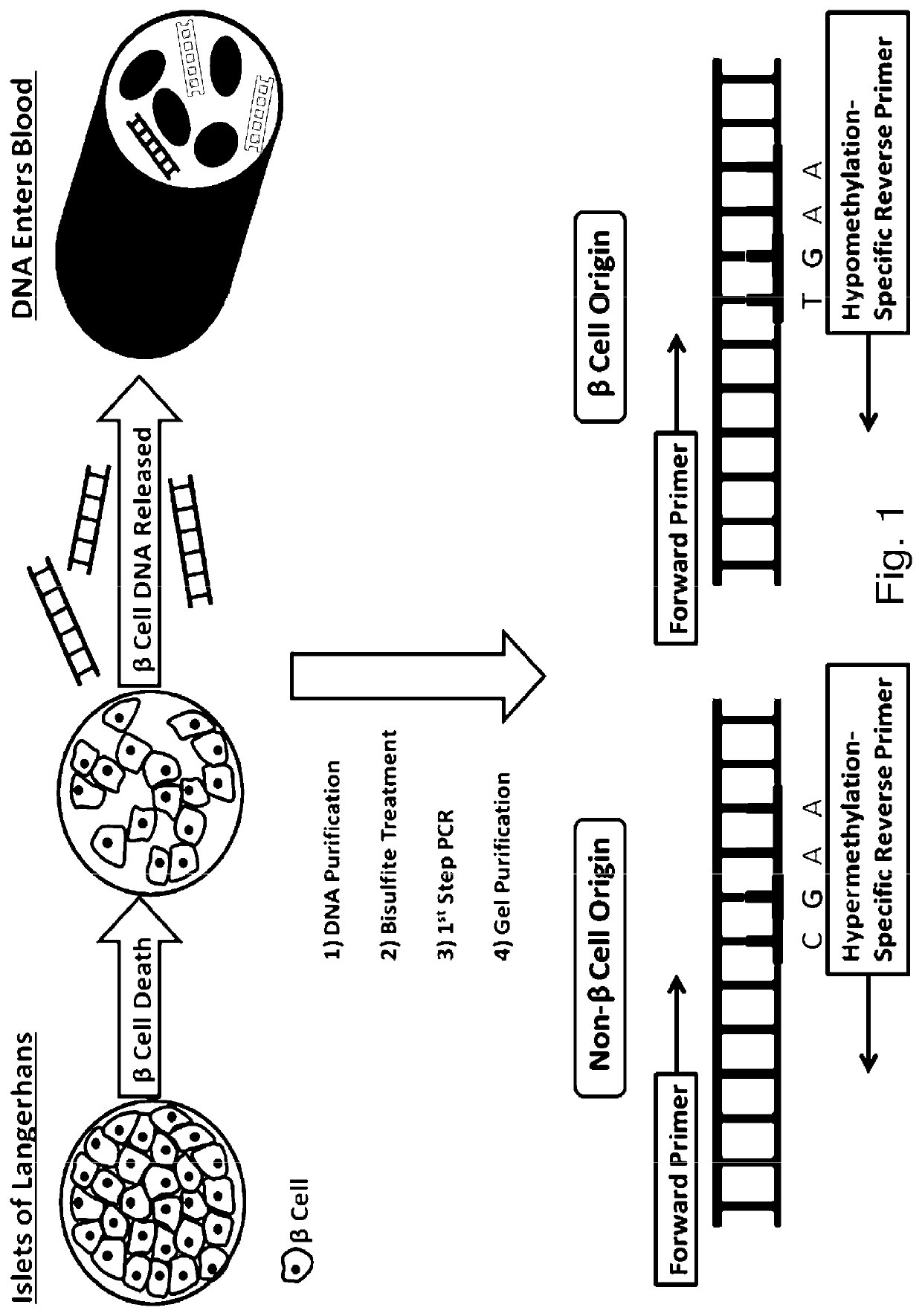System, method and kit for analysis of circulating differentially methylated DNA as a biomarker of beta-cell loss
a biomarker and beta-cell technology, applied in the field of epigenetic analysis, can solve the problems of single demethylated gene to assess cell pathology that may yield incomplete or contradictory results, and the correlation of demylated dna for insulin and amylin genes is not 100%, so as to prevent or reduce the degradation of dna
- Summary
- Abstract
- Description
- Claims
- Application Information
AI Technical Summary
Benefits of technology
Problems solved by technology
Method used
Image
Examples
example 1
Experimental
[0126]Female NOD / LtJ mice were obtained pathogen-free from the Jackson Laboratory (Bar Harbor, Me.) and maintained under pathogen-free conditions. Eight-wk old NOD mice were screened for hyperglycemia every 2-4 wks and were diagnosed with diabetes when glucose levels >200 mg / dL were measured in whole blood from the tail vein using a Glucometer Elite XL (Bayer A.G., Whippany, N.J.). Blood for DMI analysis was collected by cheek pouch bleeding, thereby allow for monitoring of β-cell death in the same animal until the development of frank hyperglycemia. All animal use and husbandry protocols were approved by the Winthrop-University Hospital Institutional Animal Care and Use Committee.
[0127]Intraperitoneal glucose tolerance test (IPGTT) was done as previously described (Akirav (Diabetes 2011)). In brief, mice undergoing an IPGTT were fasted overnight and received a 2 g / kg intraperitoneal (i.p.) dextrose injection. Whole-blood glucose levels were measured from the tail vein a...
example 2
[0156]Methylation-Specific Analysis
[0157]As an alternate to use of qRTPCR, DNA probes may also be used to quantify the relationship between the demethylated (hypomethylated) DNA from β-cells, and methylated (hypermethylated) DNA from non-β-cell origin, from various sources, such as circulating DNA (serum), or DNA in saliva or urine, for example.
[0158]DNA from serum samples is purified using the Qiagen QIAamp DNA Blood Kit following the manufacturer-recommended protocol. Synthetic unmethylated and methylated DNA is available from Millipore. Purified DNA is quantitated using a NanoDrop 2000 spectrophotometer. As per Example 1, DNA is subjected to bisulfite treatment and purified on a
[0159]DNA binding column to remove excessive bisulfite reagent using the Zymo EZ DNA Methylation Kit, and then amplified using PCR. Bisulfite-treated DNA template was added to ZymoTaq™ Premix (see, www.zymoresearch.com / protein / enzymes / zymotaq-dna-polymerase) Using the forward and reverse primers, PCR is co...
PUM
| Property | Measurement | Unit |
|---|---|---|
| Tm | aaaaa | aaaaa |
| Tm | aaaaa | aaaaa |
| Tm | aaaaa | aaaaa |
Abstract
Description
Claims
Application Information
 Login to View More
Login to View More - R&D
- Intellectual Property
- Life Sciences
- Materials
- Tech Scout
- Unparalleled Data Quality
- Higher Quality Content
- 60% Fewer Hallucinations
Browse by: Latest US Patents, China's latest patents, Technical Efficacy Thesaurus, Application Domain, Technology Topic, Popular Technical Reports.
© 2025 PatSnap. All rights reserved.Legal|Privacy policy|Modern Slavery Act Transparency Statement|Sitemap|About US| Contact US: help@patsnap.com



